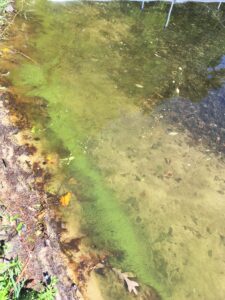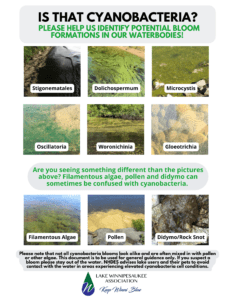Stay up-to-date on harmful algal blooms in the state this summer!
NHDES strongly recommends you utilize these resources prior to visiting a waterbody.
1.) SIGN UP FOR OUR WEEKLY UPDATES
2.) VIEW THE ADVISORIES AND ALERTS ON OUR MAP
3.) GET ALERTS FOR SPECIFIC WATERBODIES
For further information about Harmful algal blooms (HAB’s) see:
https://www.des.nh.
What are Cyanobacteria?

Cyanobacteria are small photosynthesizing, sometimes nitrogen-fixing, single celled bacteria that grow in colonies in freshwater systems. Cyanobacteria blooms can (but not always) produce microcystins and other toxins that pose a serious health risk to humans, pets, livestock, and wildlife, such as neurological, liver, kidney, and reproductive organ damage, gastrointestinal pain or illness, vomiting, eye, ear, and skin irritation, mouth blistering, tumor growth, seizure, or death. Blooms can form dense mats or surface scum that can occur within the water column or along the shoreline. Dried scum along the shoreline can harbor high concentrations of microcystins that can re-enter a waterbody months later.
There are several different species of cyanobacteria, such as:
- Anabaena/Dolichospermum: typically observed as filaments, associated with microcystins, anatoxins, saxitoxins, and cylindrospermopsin, documented in Lake Kanasatka in 2020, 2021 and 2022.
For a detailed history of cyanobacteria blooms documented on Lake Kanasatka from 2009-2021 navigate to 2.1.5 Phytoplankton (Cyanobacteria) and Zooplankton on page 15 of the Lake Kanasatka Watershed Management Plan.
Cyanobacteria Presentation from Amanda McQuaid
(Professor of Water Quality and Ecotoxicology/Director of LLMP Program, UNH Cooperative Extension)
Click Here for a Cyanobacteria FAQs List
History of Cyanobacteria Blooms on Lake Kanasatka
2024
8/28/2024 – 9/4/2024 (Oscillatoria)
2020-2022
8/12/2020 – 8/27/2020 (Anabaena/Dolichospermum)
9/29/2020– 10/09/2020 (Anabaena/Dolichospermum/Microcystis, Woronichinia/Aphanizomenon/Gloeotrichia)
8/4/2021 – 8/18/2021 (Dolichospermum)
9/13/2021 – 9/21/2021(Dolichospermum)
7/29/2022 – 8/11/2022 (Dolichospermum/Anabaena/Tolypothrix/Calothrix)
8/29/2022 – 11/16/2022 (Dolichospermum)
2023 (Total of 127 Days)
6/2/2023-6/16/2023
8/7/2023-8/31/2023
9/22/2023-12/14/2023
12/26/2023-01/02/2024
The Rapid Response Team (RRT) was formed in 2020 to respond to suspected cyanobacteria blooms anywhere on Lake Kanasatka. The RRT views suspected blooms and coordinates directly with key representatives of NHDES and UNH and Lake Winnipesaukee Association. We safely collect and handle samples, properly store the samples, and get them to NHDES or UNH in a timely manner. LKWA will ensure the Kanasatka community is promptly informed with any advisory information from NHDES. Click Here for a List of Members of the LKWA RRT .
Contact the RRT via Email: [email protected]
The RRT does not actively patrol the lake and is reliant on lake residents and visitors to let us know if you see a suspected bloom.
Follow the Protocol Below If You Suspect Cyanobacteria

Why are we seeing it now?
Cyanobacteria are becoming more prevalent in low-nutrient lake systems likely due to climate change warming effects (e.g., warmer water temperatures, prolonged thermal stratification, increased stability, reduced mixing, and lower flushing rates at critical low-flow periods that allow for longer residence times) that allow cyanobacteria to thrive and outcompete other phytoplankton species (Przytulska, Bartosiewicz, & Vincent, 2017; Paerl, 2018; Favot, et al., 2019).
In addition to warming waters, cyanobacteria blooms are a result of excessive nutrients, in particular phosphorus. Sources of phosphorus in the watershed include development, stormwater runoff, shoreline erosion, fertilizer, poorly or non-functioning septic systems, and animal waste
Fact Sheets and Resources
NHDES HABs Infographic
LKWA Rapid Response Team
Blooms and Mats Observed Across Several NH Lakes NHDES Press Release
NHDES Harmful Algal Blooms Website
“The Dirty Dozen” 12 Toxic Cyanobacteria of New England
UNH: What are Cyanobacteria and Why Should You Care?
“It is unlikely that cyanobacteria will be fully eradicated in the Lake Kanasatka watershed; some species of cyanobacteria can become dormant in sediment and then can jump-start cell reproduction once conditions are favorable (warm water temperatures and plenty of sunlight and nutrients). Given the long-term trend of increasing hypolimnion total phosphorus concentration in the lake, the likelihood of blooms will continue and possibly accelerate, though year-to-year variability in weather may determine the availability of phosphorus and/or the presence of other oxygen compounds such as nitrates and thus determine the timing, extent, and severity of blooms in any given year. Despite this, conditions favorable for blooms can be substantially minimized by reducing nutrient-rich runoff from the landscape during warm, sunny spells. Water level and flow also helps to either flush out blooms or limit upstream nutrient sources to stymie growth.” -Lake Kanasatka WMP
